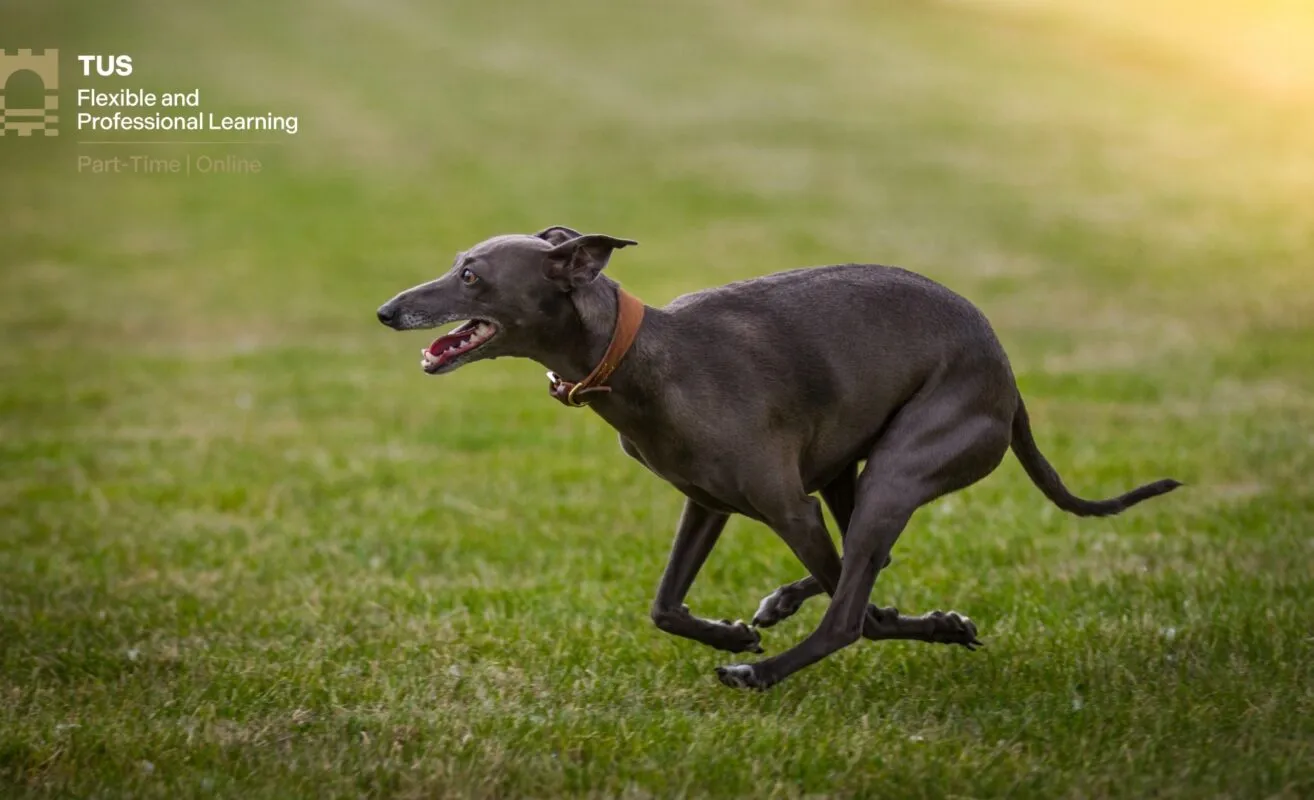Courses
Admissions & Support
Course Search
Courses
Admissions & Support
Course Search
Our Services
Our Community
Course Search
Governance
Professional Services
Status: Register Your Interest
Location: Moylish, Limerick City
Fees: €1,000 -Students will contribute 25% of the fee: €250

Aim of the Program
The aim of this special purpose award is to provide learners knowledge of the health necessary for a greyhound coupled with skills in relation to injury detection and injury management and a knowledge of the potential benefits and negative impact of drugs on greyhounds.
Learning Outcomes
On completion of this module the learner will/should be able to;

Entry Requirements
The course is aimed at current participants in the greyhound industry, with the objective of increasing their knowledge of the care and welfare of the greyhounds that they work with.
Week 1 Introduction to course; Anatomy of the greyhound
Week 2 Respiratory and Cardiovascular systems
Week 3 Digestive and Urinary systems
Week 4 Diseases and Conditions of the Young and Adult Greyhound
Week 5 Greyhound Physiotherapy and Managing the Injured Dog
Week 6 The Healthy Greyhound and Signs of Ill-health
Week 7 Medicines and the Greyhound
Week 8 Surgical repair of injuries
Week 9 Drug testing procedures
Week 10 Sports drug analysis and controls
Week 11 Anabolic steroids and modern developments in doping
Week 12 Caring for the sick and injured greyhound
Week 13 Positive analytical findings and follow-up procedures
Week 14 International anti-doping controls in humans and animals
Week 15 Caring for the older retired greyhound
Identify the common signs of ill health and injuries in a greyhound and explain when veterinary expertise/treatment is required
Demonstrate an understanding how to examine and evaluate the more common injuries of the Head/Neck; Forelimb; Hindlimb, Feet/Toes and Back.
Understand the different grades of muscle tear/injury.
Knowledge of the basic changes that occur in muscle fibres/cells following injury and thereafter during the repair process.
Knowledge of the basic science as to how individual forms of therapy (physiotherapy, ultrasound and laser therapies) work, what determines when to use them and understand their limitations as forms of treatment.
Understand the common conditions, how they manifest themselves and the corrective actions/preventative measures to be taken particularly in relation to hydration, dehydration and muscle cramping.
Understand basic differences between diseases caused by viruses, bacteria, helminthes(worms), protozoan parasites and fungi.
Demonstrate an understanding of and explain how to prevent injuries and the proper use of medicines such as antibiotics, anti-inflammatories and painkillers
Demonstrate an understanding of the proper use of antibiotics and anti-inflammatory/painkillers from puppy to geriatric stages of life.
Identify and name the important external and internal anatomical features/organs
Demonstrate an understanding of the basic anatomy of the Musculoskeletal System.
Identify the main bones, joints, tendons and muscles using standardised terminology.
Understand how the bony skeleton, muscles, tendons and ligaments and joints all interact to permit the smooth movement of the racing greyhound.
Identify the main bones and muscles which are subject to injury during racing.
Demonstrate an understanding of the physiology of bone.
Give a basic description of how bone develops from cells and grows and hardens.
Understand how fractured bones heal.
Demonstrate an understanding of the physiology of muscles.
Knowledge of basic muscle structure and what happens within fibres when muscles contract and relax.
Knowledge of causes of involuntary contraction of muscles (cramping).
Describe the various body systems and have a basic knowledge of the physiological functions of the respiratory, circulatory, digestive, urinary and musculoskeletal/neurological systems.
Demonstrate an understanding of the Respiratory System.
Name the various parts, describe how they are connected and function in delivering oxygen to and carbon dioxide from the bloodstream.
Knowledge of the unique anatomy of the larynx, bronchi/bronchioles and how this enhances the functioning of breathing.
The importance of the system in controlling a dog’s body temperature through the mechanism of panting.
Demonstrate an understanding of the cardiovascular system.
Knowledge of the production and functions of the components of blood: red/white blood cells, platelets and plasma.
Understand the circulatory system and function of the heart, blood vessels and lymph vessels.
Demonstrate an understanding of the Digestive System.
Knowledge of the functions of the teeth/mouth, oesophagus, stomach, small intestine, liver, pancreas and large intestine.
Knowledge of how food is converted from its raw state when eaten to being digested in the stomach and small intestine through exposure to acids and various enzymes.
The importance of the liver in filtering nutrients that are absorbed into blood from the small intestine and also its role in breaking down sugars and fats into useful compounds.
Demonstrate an understanding of the Urinary System.
Understand the basic functioning of kidneys and the particular importance of an adequate intake of fluids by a racing greyhound.
Explain how and why therapeutic medications are administered to canine athletes and be familiar with the different canine regulatory approaches to drug control
Stimulants and Sedatives/Tranquillisers — Why they are used and the nature of the substances used; Other substances used.
Drugs which act on (i) the autonomic system, (ii) the cardiovascular system, (iii) the central nervous system.
Drugs which act on (i) the coagulation of blood, (ii) the gastro-intestinal function, (iii) the immune system and its responses.
Analgesics, antipyretic and anti-inflammatory drugs.
Antibiotics, synthetic antibacterial and antiviral drugs.
Antihistamines; Antimalarial and other antiparasitic agents.
Cytotoxic substances; Diuretics; Endocrine secretions and their synthetic counterparts.
Local anaesthetics; Muscle relaxants; Respiratory stimulants; Sex hormones, anabolic steroids and corticosteroids.
Anabolic Steroids — Effects of anabolic steroids and the methodology for the confirmatory analysis of anabolic androgenic agents in racing animals:
Explain the greyhound sampling process and sample transfer to the laboratory as well as key concepts such as withdrawal times, reporting levels, action/decision levels, thresholds, screening analysis and confirmatory analysis
Detection and Analysis — An Overview
Lectures – 15 weeks x 2.5 hours per week in a blended learning approach
Site Visits – 3 site visits during the duration of the program
Laboratory – 6 hours per module
Worksheets/Multiple Choice Question’s
Practical Evaluation
Interview
€1,000 -Students will contribute 25% of the fee, €250. 75% of the fee, equating to €750 will be covered by Greyhound Racing Ireland for eligible participants.